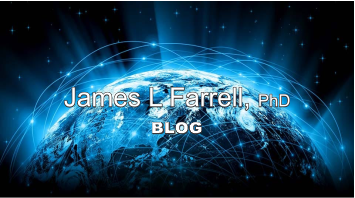CONING in STRAPDOWN SYSTEMS
Free-inertial navigation uses accelerometers and gyros alone, unaided. For that purpose pioneers of yesteryear developed a variety of techniques, ranging from a 2-sample approach (NASA TND-5384, 1969) by Jordan to his and various others’ higher-order algorithms to reduce errors from noncommutativity of finite rotations in the presence of coning ( and / or pseudo coning). The methods showed considerable insight and produced successful operation. Since it’s always good to have “another tool in the toolbox” I’ll mention here an alternative. What I describe here isn’t being used but, with today’s processing capabilities, could finally become practical. The explanation will require some background information; I’ll try to be brief.
A very old investigation (“Performance of Strapdown Inertial Attitude Reference Systems,” AIAA Journal of Spacecraft and Rockets, Sept 1966, pp 1340-1347) used the usual small-angle representation for attitude error expressed in the vehicle frame. With that frame rotating at a rate
omega the derivative of that vector therefore contains a cross product of itself crossed with
omega . One contributor to that product is a lag effect from
omega premultiplied by a diagonal matrix consisting of delays (e.g., transport lags equated to reciprocals of gyro bandwidths). Mismatch among those diagonal elements produces drift components with nonzero average, e.g., the x-component of the cross product is easily seen to be
(difference between y and z lags) times (omega_y) times (omega_z).
Even with zero-average (e.g., oscillatory) angular rates, that product has nonzero average due to rectification. I then characterized the lags as delays from computation rather than from the gyros, with the lag differences now proportional to nonuniformities among RMS angular rate components along vehicle axes, and average products proportional to cross-correlation coefficients of the angular rate components. That was easy; I had a simple model enabling me to calculate the error due to finite gyro sampling rates producing finite rotation increments that don’t commute.
A theoretical model is only that until it is validated. I had to come up with a validation method with mid-1960s computational limitations. Solution came from a basic realization: performance doesn’t degrade from what’s happening but from belief in occurrences that aren’t happening. The first-ever report of coning (Goodman and Robinson, ASME Trans, June 1958) came from a gimballed platform that was believed to be stable while it was actually coning. If the true coning motion they described had been known and taken into account, then their high drift rates never would have occurred. The reason they weren’t taken into account then was narrow gimbal servo bandwidth; the gyros responded to the coning frequency but the platform servos didn’t. Now consider strapdown with the inverse problem: pseudo coning — a vehicle believed to experience coning when it isn’t. That will fall victim to the same departure of perception from reality. If you gave the same Goodman and Robinson coning motion to their strapdown gyro triad and sampled them every nanosecond, the effect from noncommutativity wouldn’t be noticeable.
Armed with that insight I then chose rotational dynamics with a closed form solution. Although rotations about fixed vehicle axes produced no coning, the pseudoconing was severe, with the apparent (reported-from-gyros) rotation axis changing radically within fractions of a millisecond; too fast for the 10 kHz data rate used in that computation. The cross product formulation was then validated by making extensive sets of runs, always comparing two time histories:
* a closed form solution for a true direction cosine matrix corresponding to a vehicle experiencing a sinusoidal
omega
* an apparent direction cosine matrix, obtained by brute-force but meticulous formation from processing gyro outputs at finite rates with quantization, time lags, and a wide variety of error sources.
That “bull-by-the-horns” computation allowed extended runs (up to a million attitude iterations) to be made for a wide range of angular rate frequencies, axis directions, and combinations of gyro input errors (steady, random, motion-sensitive, etc.). Deviation of apparent attitude from closed-form truth was consistently in close conformance to the analytical model, for a host of error sources. I have to admit that this “bull-by-the-horns” approach gave me an advantage of finding out answers before I understood the reasons for them. The cross-product analytical model didn’t come from my vision; it came after much head-scratching with answers computed from dozens of runs. A breakthrough came from the sensitivity, completely unanticipated, to angular acceleration about gyro output axes — clear in retrospect but not initially. After these experiences it occurred to me: if cross-axis covariances were known, the dominant contributor to errors — including noncommutativity — could be counteracted. I noted that on page 1342 of that old AIAA paper.
Finally I can describe the alternative means of compensating the dominant computational error. Description begins with the reason why it would be useful. Earlier I mentioned that many authors developed very good algorithms to reduce errors from noncommutativity of finite rotations in the presence of coning and/or pseudoconing. All that history, plus more detailed presentation of everything discussed here, can be found in Chapters 3 and 4 of my 1976 book plus Addendum 7.A of my 2007 book. A supreme irony upstages much of the work from those brilliant authors: without accounting for gyro frequency response characteristics, the intended benefit can be lost — or the “compensation” can even become counterproductive (Mark and Tazartes, AIAA Journal of Guidance, Control, & Dynamics, Jul-Aug 2006, pp 641-647). As if those burdens weren’t enough, the adjustment’s complexity — as shown in that paper — can be extensive. So : that motivates usage of a simpler procedure.
By now I’ve put so much explanation into preparing its description that not much more is needed to define the method. Today’s signal-processing boards enable the requisite covariances to be repetitively computed. Then just form the vector cross product already described and subtract the result from the gyro increments ahead of attitude updating. So much for coning and pseudoconing — but I’m not quite finished yet. The paper just cited leads to another consideration: even if we successfully removed all of the error theoretically arising from inexact computation, significant improvement in free-inertial performance would require more. Operation in the presence of vibrations would necessitate reduction of other motion-sensitive errors. Gyro degradations from rotations, for example, would have to be compensated — and that includes a multitude of components. For that topic you can begin with the discussion of gyro mounting misalignment following that up with the tables in Chapter 4 of my 1976 book and Addendum 4.B of my 2007 book.










